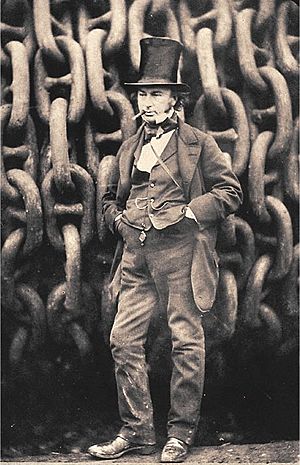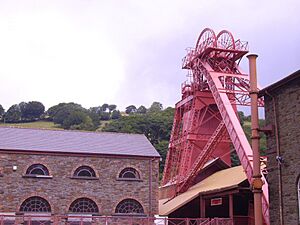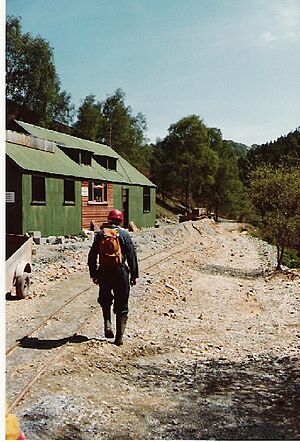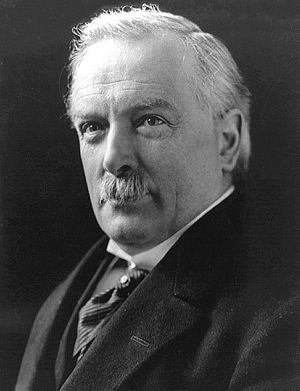Industrial Revolution in Wales facts for kids
The Industrial Revolution in Wales was a time of big changes in Wales during the 1700s and 1800s. New machines and ways of working led to a huge growth in factories and mines. This period completely changed how people lived and worked across the country.
Contents
North-East Wales: A Mix of Industries
North-East Wales, especially Flintshire, became home to many different types of factories. By the late 1700s, places like Holywell had 19 metalworks, and Buckley had 14 pottery factories. There were also cotton mills in Holywell and Mold. The mining of lead and coal also grew a lot.
The Wrexham area was very industrial in the 1800s. At its busiest, 38 coal mines were working there, digging up over 2.5 million tonnes of coal each year. This coal was used by many brickworks and steelworks, including Brymbo Steel Works. In Bersham, near Wrexham, the Bersham Colliery (a coal mine) and Bersham Ironworks were important. This ironworks was a leader in Europe because it used coke (a special type of fuel) instead of charcoal to melt iron.
Greenfield, also in Flintshire, is famous for making paper. A paper mill has been there since 1770. The site was perfect because of the constant water flow from a stream coming from St Winefride's Well. This quick development helped link Greenfield to the start of the Industrial Revolution. By the mid-1800s, about 80 businesses had set up along a mile-long stretch between Holywell and Greenfield. Today, you can still see the remains of some of these old factories. They included copper mills, flannel mills, flour mills, shirt-makers, and even soft drink factories. Greenfield also had two Courtaulds rayon factories and a sulphuric acid plant from 1936 to 1985.
Dolgellau Gold: A Rush for Riches
Gold was found near Dolgellau in the 1850s, leading to a "gold rush." The first gold was found at Gwynfynydd in 1863, but it wasn't until 1887 that the mine really started working. William Pritchard Morgan, known as the "Welsh gold king," bought the mine. He even paid for two police officers to guard it! By 1888, 200 people worked there. Miners dug horizontal tunnels deep into the mountainside, working by candlelight. Machines were powered by water wheels and water turbines. Unlike other mines where gold was found near the surface, Gwynfynydd's gold came from large quartz veins deep underground.
The Clogau gold mine opened to dig for copper and lead. In 1854, gold was found there in a quartz vein. This main gold vein was called the "St. David's lode." In 1860, they got permission to mine the gold for business. Mining started on August 28, 1860. Clogau produced a lot of gold in the 1890s. In 1899, it produced gold worth £60,000 (which would be a lot more money today!). The mine reopened in 1919 when new gold veins were found. In 1989, William Roberts, who started Clogau Gold of Wales Ltd., reopened the mine. Gold was mined again from 1992 to 1998, providing gold for Clogau Gold jewellery. Mining stopped in 1998 because it became too expensive, and less gold was being found.
South Wales Valleys: Iron, Coal, and People
In the early 1800s, parts of Wales became very industrial. Ironworks were built in the South Wales Valleys, especially around the new town of Merthyr Tydfil. Iron making later moved west towards Neath and Swansea, where anthracite coal was already being mined. From the 1840s, coal mining spread to the Cynon and Rhondda valleys. This led to a huge increase in the number of people living in these areas.
Glamorgan: The Heart of Industry
Metal Production
From the mid-1700s, Glamorgan's uplands became very industrial. Coastal towns like Swansea and later Cardiff grew into important ports. From the late 1700s to the early 1900s, Glamorgan produced 70% of Britain's copper. This industry was mainly in the west of the county. Coal was cheap there, and copper ores could be brought in from places like Cornwall and Devon. The copper industry was very important to Swansea. In 1823, the copper factories along the River Tawe, and the coal mines and ships that depended on them, supported 8,000 to 10,000 people.
Imports of copper ore reached their highest point in the 1880s, then fell sharply until the 1920s. It became too expensive to ship ores from far away, and other countries started making their own copper. Some factories switched to making zinc. The Tawe valley also started making nickel after Ludwig Mond built a factory in Clydach in 1902.

Even at its busiest, copper smelting (melting metal) was not as big as iron smelting. Iron making was the largest employer in South Wales before coal became so important. Ironworks were built where ironstone, coal, and limestone were found close together. This was mainly in the northern and south-western parts of the South Wales coalfield. In the late 1700s, four ironworks were built in Merthyr Tydfil. The Dowlais Ironworks started in 1759. Then came the Plymouth Ironworks in 1763, the Cyfarthfa Ironworks in 1765, and the Penydarren Ironworks in 1784. These made Merthyr Tydfil the main center for iron making in Wales.
Besides copper and iron, Glamorgan also became important for making tinplate. Many tinplate factories appeared around Swansea, Aberavon, and Neath in the late 1800s. Glamorgan became the most populated and industrial county in Wales. It was known as the "crucible of the Industrial Revolution," meaning it was a place where huge changes happened.
Other areas with heavy industries included ironworks in Maesteg (1826), tinplate works in Llwydarth and Pontyclun, and an iron ore mine in Llanharry. Factories that used the metals also appeared. Pontypridd was known for the Brown Lenox Chainworks, which was the town's main employer in the 1800s.
Coal Mining
The biggest change in industrial Glamorgan was the opening of the South Wales coalfield. This was the largest continuous coalfield in Britain and covered most of Glamorgan. The coalfield had many different types and qualities of coal. Before 1750, people mostly got coal from shallow pits or by digging into exposed seams on river banks or mountainsides.
At first, coal was dug up to be sold to other places. But soon, it was also needed for melting metals in Britain's growing industries. Coal mining started to grow in the north-eastern part of Glamorgan, near the ironworks of Merthyr, and in the south-west, near Swansea's copper factories. In 1828, the South Wales coalfield produced about 3 million tons of coal. By 1840, this had risen to 4.5 million tons, with about 70% used locally.

The 1840s saw a huge increase in coal mining in Glamorgan. Several things caused this growth. Steam coal was discovered in the Cynon Valley, a large dock was built in Cardiff, and the Taff Vale Railway was constructed. In 1845, after tests by the British Admiralty (the Royal Navy), Welsh steam coal became the preferred fuel for Royal Navy ships, replacing coal from Newcastle. Glamorgan steam coal quickly became popular for navies worldwide, and its production increased to meet the demand.
The richest source of steam coal was the Rhondda Valleys. By 1856, the Taff Vale Railway had reached the heads of both valleys. Over the next 50 years, the Rhondda became the biggest coal producer of its time. In 1874, the Rhondda produced 2.13 million tons of coal, which grew to 5.8 million tons by 1884. Glamorgan now produced much more coal than it needed, so in the late 1800s, it became a major exporter. In the 1890s, the docks of South Wales handled 38% of all British coal exports and a quarter of the world's coal trade.
With more coal production came a very large increase in population. People moved to the area to find jobs. In Aberdare, the population grew from 6,471 in 1841 to 32,299 in 1851. The Rhondda grew from 3,035 in 1861 to 55,632 in 1881, reaching its peak in 1921 with 162,729 people. Much of this growth was due to people moving in. Between 1881 and 1891, over 76,000 people moved to Glamorgan. Most of them came from England.
Lower Swansea Valley: Copperopolis
Coal and Metals
For about 150 years, until the 1920s, the River Tawe valley became one of the most industrial areas in the world. Several reasons helped industry grow so much here. The South Wales coalfield had steam coal and anthracite coal close to the surface in the Upper Swansea valley. This coal was easy to dig up using shallow drift mining (digging into a hillside) or open cast mining (digging from the surface).
Melting metals needed more than three parts of coal for every one part of metal ore. So, it was a big money-saver to have easily available, high-quality coal. Swansea also had a good port and a safe place for ships to anchor. Because of this, it was cheaper to bring the metal ore to Swansea's coal than to take the coal to the ore. Also, Swansea's very high tidal ranges meant that large ships could sail right into the river mouth. This allowed huge amounts of raw materials to be brought in and, more importantly, finished products like copper sheets, tinplate, and coal to be exported.
The ways of making iron were already well developed, and skilled workers were ready to help the new industries grow. Swansea was already a big town that could provide the workers needed. The growth of industry in the Lower Swansea valley made Swansea and nearby Neath much larger. Many rich business owners, scientists, and engineers came to Swansea during this time. This led to many new ideas and improvements in how things were made.
At first, the factories focused on melting copper. Coal was brought down to them by special tracks for wagons. Copper ore came on ships that could sail right up to the factories. The finished copper was then shipped out the same way. Swansea became known as "Copperopolis" because of all the copper factories. The lower Tawe valley became a huge industrial area. After the copper and coal industries, other businesses followed, like pottery making (which also needs a lot of coal), the alum industry, and factories making fire-clay for lining furnaces.
Copper Production
The first copper smelter in the area was built at Landore in 1717 by John Lane and John Pollard. Pollard later built the Llangyfelach copper works. In 1720, the Cambrian Works started near the river mouth. By 1780, there were three copper works on the east side of the river: White Rock, Middle, and Upper Bank. There was also one on the west side at Forest. By 1800, nine copper smelters were working in the valley. By 1860, the lower Swansea valley was melting two-thirds of all the copper ores brought into Britain. Changes in Swansea's copper output affected copper prices around the world.
Post-War Industry: Changes and Challenges
After the Second World War, many traditional industries in Wales started to decline. The coal industry was especially affected. At its peak around 1913, over 250,000 men worked in the South Wales coalfield. This number fell to about 75,000 in the mid-1960s and 30,000 in 1979. The coal mining industry in Britain became owned by the government in 1947, so Welsh mines were controlled by the National Coal Board (NCB).
This period also saw the Aberfan disaster in 1966. A huge pile of coal waste slid down a mountain and covered a school, killing 144 people, most of them children. By the early 1990s, only one deep coal mine was still working in Wales. Tower Colliery, in Hirwaun, stayed open until 2008. It had been run by its workers since 1994. The steel industry also saw a similar decline. The Welsh economy, like many others, started to rely more on service jobs, like in shops and offices.
Society: Life and Protests
Uprisings and Protests
The big changes from industrialization led to conflicts between Welsh workers and the mostly English factory and mine owners. In the 1830s, there were two armed uprisings. One was in Merthyr Tydfil in 1831, and another was the Chartist uprising in Newport in 1839, led by John Frost. The Rebecca Riots happened between 1839 and 1844 in South and Mid Wales. These were protests by people in the countryside. They were angry about high tolls (fees) on roads and about being poor in rural areas.
The "Treason of the Blue Books"
Because of these troubles, the government looked into the state of education in Wales. Three English officials, who did not speak Welsh, carried out the study. They got information from witnesses, many of whom were Anglican church leaders. Their report, published in 1847, said that Welsh people were uneducated, lazy, and immoral. It claimed this was because of the Welsh language and nonconformity (Protestant religions that were not the official Church of England). This report caused a huge angry reaction in Wales and was called the "Treason of the Blue Books."
The Rise of Socialism
Socialism quickly became popular in the industrial areas of South Wales in the late 1800s. Religious Nonconformism also became more involved in politics. The first Labour Member of Parliament (MP), Keir Hardie, was elected for the Welsh area of Merthyr Tydfil and Aberdare in 1900. Like many European countries, the first movements for Wales to have more control over its own affairs began in the 1880s and 1890s. This was with the group Cymru Fydd, led by Liberal Party politicians like T. E. Ellis and David Lloyd George.
See also
Images for kids





